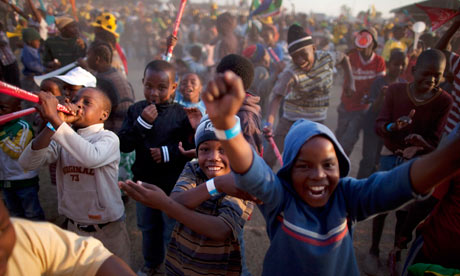
In the 12 months I lived in Johannesburg during the late 90s, I only went to Soweto, just a few miles away, once. That was for a wedding of a colleague when, embarrassingly, as the only white person present, I was parked on the top table.
This time, I'm staying in a B&B in the heart of Soweto, just off the famous Vilakazi Street. This is where Nelson Mandela and Desmond Tutu once lived (perhaps the only street in the world to have housed two Nobel peace prize winners).
A couple of hundred yards away is the Hector Pieterson Museum that records the events of 16 June 1976 when up to 200 black schoolchildren were shot dead for expressing their displeasure at learning in Afrikaans.
And across the highway, right next to cows grazing in the long grass of the veld, is Orlando Pirates stadium where R Kelly and co kept us up late at the World Cup opening concert.
You can see the World Cup effect here. Aside from the ever-present vuvuzelas and the flags attached to the metal gates of the houses on the street of our B&B, there are new signs welcoming tourists and explaining the history of the area. There are also the curio stalls and white minibuses driving about – standard issue whenever visitors venture into this township.
No one's going to the games though. Or least no one I could find. People look at you in a quizzical way if you ask if they have a ticket. It's not an option. One man who did manage to get into the opening game against Mexico said that he'd never seen a whiter or a quieter crowd at a Bafana Bafana game.
For most Sowetans, this World Cup is about watching the games on TV - in their homes and in the bars.
I spent an afternoon in Kliptown on the day the tournament began. This is one of the poorest areas of Soweto, which in turn is poor compared with the suburbs of Jo'burg. People live in shacks made of salvaged plywood, corrugated iron and plastic sheets.
I ended up next to a stall selling fruit, sweets and chicken intestines. Two girls were pulling the skin off these pale pink tubes, and putting them into small clear plastic bags to sell.
"Are you angry that the investment has not reached here?" I asked them.
"Not at all," they replied. "We're just happy that the World Cup is here."
I couldn't find anyone who resented the millions of rand that have been spent, even though not one rand appears to have made it to Kliptown.
A couple of days later, I visited the brilliant community station Jozi FM to see what their listeners think of the foreign media. All the callers accused us of being too negative, and too quick to doubt South Africa. One billboard up the road read: "The day we won the world's respect." Sowetans seem upset it took this long for South Africa to be taken seriously by the rest of the world.
The frustration here, though, is that while South Africa may be winning people over, Soweto has not yet managed to pull off the same trick. The visitor numbers remain relatively small, and in the mind of potential visitors its reputation for being dangerous - undeserved though it is - trumps its riveting history and euphoric music.
This was played out for me in stark fashion on a visit to Nelson Mandela Square in the upmarket Johannesburg suburb of Sandton. The night before I'd stood in a deserted Fanzone in Soweto wondering where all the fans were. The answer was Sandton.
Thousands of them clogged the high-sided plaza. When I asked why they were here, many answered it was the only place they felt safe. One Chilean admitted that while he was very curious to explore, he'd been "brainwashed" by all the talk of crime.
So here they all were – in a square that felt more like a pen, shopping in a mall that could have been anywhere in the world and was straight out of the Las Vegas-hotel school of architecture. Soweto couldn't have felt further away.
On returning, I recounted the story to my neighbours. They weren't surprised. They are used to people being scared of where they live. Stop and think about how that feels when the South African police say again and again it's no more dangerous here than anywhere else in the city.
The beginning of the World Cup created such euphoria here I struggled to get any sense of how people really felt about their lives and their country. Now, though, in my third week here and with the Bafana Bafana dream over, I'm starting to see the frustrations I thought must exist.
There is a tension between what people want Soweto to be and what it is; and what it is and how it's perceived.
Of course, these are the impressions of a visitor, not an expert. If you live in Soweto, or have visited, do you see the same place that I do?
• Ros Atkins presents the BBC World Service World Cup Have Your Say blog and the BBC World News during the World Cup, and is the regular presenter of World Have Your Say

